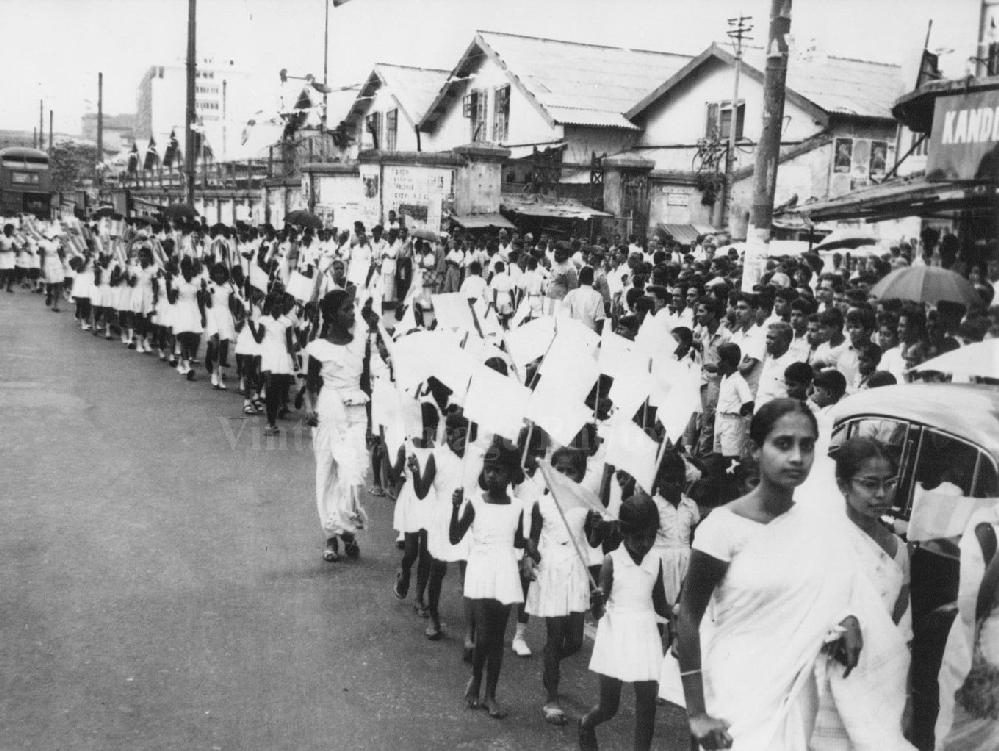
Sri Lanka History: Revival of Buddhism (Late-19th / early-20th century)

Figure 1.--Buddhism after the mid-19th century was dieing out in Sri Lanka as it had in India. Buddhist institutions had either disappeared or were moribund. Most of the popultion had little knowlege their spiritual heritage. It is at this time that three individuals reversed the state of affairs. The Sri Lankans were Mohottivatte Gunananda (1823-90) and Mohottivatte Gunananda (1823-1890) and Anagarika Dharmapala (1863-1933). And most remarably one was an American -- Henry Steel Olcott (1832-1907), a New York customs lawyer. The press caption here read, "Children's Corps: Twenty-five thousand Ceylonese schoolchildren marched to the ceremony in Colombo that honored H.S. Olcott, an American." The photograph was taken in 1967.
|
|
An imprtant factor in the mationlist movement and resulting indenendence movement was the revival of Buddhism and Hinduism in Sri Lanka, especially Buddhism. Buddhism rose first in India and then spread to two countries Gandhara and Ceylon. Gandhara controlled an area includig modern Afghanistan. The Buddhas of Bamiyan were 4th- and 5th-century monumental statues destroyed by the Taliban. Since Buddhism died out in India and Gandhara, the oldest living Buddhist tradition today is Sri Lanka. Today about 70 percent of the citizens of Sri Lanka are Theravada Buddhists, but in the 19th century Buddhism almost died out in Sri Lanka. It was the Indian Emperor Ashoka the Great (304-232 BC) that helped bring Buddhism to Sri Lanka, influencing King Tissa of Ceylon. Beginning with the Court Buddhism spread and flourished. Political instability within Ceylon combined with invasions by the Hindu Tamils of southern India weakened Buddhism in Ceylon (6th century AD). Buddhism unlike the situation in India recovered in Sri Lanka (12th-13th centuries). Then Buddhism faced another challenge--European Chriustianity. This began with the Portuguese. Lourenco de Almeida landed on Ceylon and established a base port at Colombo (1505). There were several warring kingdoms in Sri Lana, this helped the Portuguese to gain control of the coast. They were agast with both Buddhism and Hinduism. They began to root out Buddhism, destroying monasteries, libraries, and art. Monks wearing saffron robes were executed. One report possibly exagerated claims that at thend of Portuguese rule, only five fully ordained monks were left (1658). .And without the monks the Buddhist traditions began to die out. The Dutch were interested in trade and not in stamping out Buddhism, but they continued to promote Christinity and under Dyutch rue there continued to be advantages to being Christian. The Britush seized control of Sri Lanka during the wars with Revolutionry France (1796). The Dutch had involuntrily become become French allies. Soon Christian missionaries were pouring into Ceylon. The British government after the Napoleonic Wars aggrssively promoted Christianity seeing it as a 'civilizing' effort. Christian opened schools throughout the island to convert the natives from 'idolatry'. The result was that by the late 19th century, Buddhism was dieing out as it had in India. Buddhist institutions had either disappeared or were moribund. Most of the popultion had little knowlege their spiritual heritage. It is at this time that three individuals reversed the state of affairs. The Sri Lankans were Mohottivatte Gunananda (1823-90) and Mohottivatte Gunananda (1823-1890) and Anagarika Dharmapala (1863-1933). And most remarably one was an American-- Henry Steel Olcott (1832-1907), a New York customs lawyer.
CIH

Navigate the Children in History Website:
[Return to the Main Sri Lankan history page]
[Return to the Main Asian history page]
[About Us]
[Introduction]
[Biographies]
[Chronology]
[Climatology]
[Clothing]
[Disease and Health]
[Economics]
[Freedom]
[Geography]
[History]
[Human Nature]
[Ideology]
[Law]
[Nationalism]
[Presidents]
[Religion]
[Royalty]
[Science]
[Social Class]
[Bibliographies]
[Contributions]
[FAQs]
[Glossaries]
[Images]
[Links]
[Registration]
[Tools]
[Children in History Home]
Created: 2:18 PM 2/11/2018
Last updated: 2:18 PM 2/11/2018



